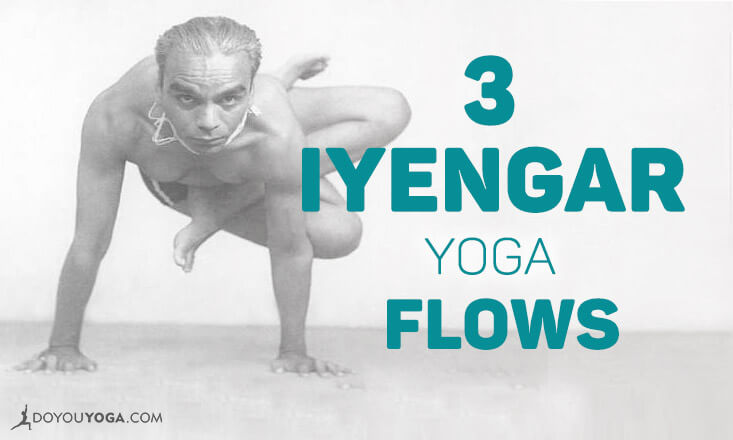Likely this title raised some eyebrows. Iyengar yoga is often referred to as an intellectual practice focusing on body alignment. Rarely is Iyengar Yoga synonymous with flow.
Read below to learn more about Iyengar yoga and to find three flows for your next Iyengar practice!
Lineage and Traditional Style
Iyengar yoga by B.K.S. Iyengar and Ashtanga yoga by Pattabhi Jois developed from the teachings of Tirumalai Krishnamacharya in Mysore, India. Therefore, it is no surprise that many asanas are similar while their approach to practice is slightly different.
Iyengar yoga traditionally is a practice of precision. The flows are generally slower, asanas/poses are traditionally held longer, and props (i.e. chairs, straps/belts, blocks, and bolsters) are utilized to help the body ease into correct alignment.
The late B.K.S. Iyengar suffered from many health concerns when he was young, including malaria, tuberculosis, and typhoid fever. As a teenager, B.K.S. Iyengar’s brother-in-law invited he to come to Mysore to try yoga to improve his health. Soon after he moved to Mysore, he started teaching yoga.
Later, he established the Ramamani Iyengar Memorial Yoga Institute (RIMYI) in Pune, India. B.K.S. Iyengar is considered one of the first teachers to bring yoga to the west. In addition, he was a major contributor to the modern asana practice.
His first book in the series of Light On was Light on Yoga, published in 1966, and is considered one of the must read books for the modern yogi.
Rooted in hatha yoga, Iyengar’s style is grounded in the physical alignment of the body. Below are three basic Iyengar flows with intentional focus:
75-minute Iyengar Flow for Self-Love
- Reclining Bound Angle Pose (Supta Baddha Konasana) – hold for 10 minutes
- Downward-Facing Dog (Adho Mukha Svanasana) – hold for 1 -2 minutes
- One Leg Reclined Hero (Eka Pada Supta Virasana) – hold for 5 minutes each side, total 10 minutes
- Downward-Facing Dog (Adho Mukha Svanasana) – hold for 1 -2 minutes
- Headstand (Salamba Sirsasana) – hold for 5-10 minutes using a wall if needed
- Downward-Facing Dog (Adho Mukha Svanasana) – hold for 1 -2 minutes
- Two-Legged Inverted Staff Pose with a Chair (Dwi Pada Viparita Dandasana) – hold for 10 minutes
- Downward-Facing Dog (Adho Mukha Svanasana) – hold for 1 -2 minutes
- Shoulderstand With or Without a Chair (Sarvangasana) – hold for 10 minutes
- Downward-Facing Dog (Adho Mukha Svanasana) – hold for 1 -2 minutes
- Seated Forward Bend (Paschimottanasana) – hold for 5 minutes
- Wind Release Pose (Supta Pawanmuktasana) – hold for 5 minutes
- Corpse Pose (Savasana) – hold for 10 minutes
75-minute Iyengar Flow for Concentration
- Mountain Pose (Tadasana) – hold for 5 minutes
- Wide-Legged Forward Bend (Prasarita Padottanasana) – hold for 5 minutes
- Reclining Bound Angle Pose (Supta Baddha Konasana) – hold for 10 minutes
- Head-to-Knee Forward Bend (Janu Sirsasana) – hold for 5 minutes each side, total 10 minutes
- Seated Forward Bend (Paschimottanasana) – hold for 5 minutes
- Camel Pose with chair (Ustrasana) – hold for 5 minutes
- Child’s Pose (Adho Mukha Virasana) – hold for 5 minutes
- Plow Pose with Chair and Bolsters (Halasana) – hold for 10 minutes
- Seated Twist (Marichyasana III) – hold for 5 minutes each side, total 10 minutes
- Corpse Pose (Savasana) – hold for 10 minutes
80-Minute Iyengar Flow for Renewal
- Mountain Pose with Reverse Prayer (Tadasana Paschima Namaskarasana) – hold for 5 minutes
- Side Twist in Hero Pose (Parsva Virasana) – hold for 5 minutes each side, total 10 minutes
- Reclining Bound Angle Pose (Supta Baddha Konasana) – hold for 10 minutes
- Intense Forward Bend (Uttanasana) – hold for 10 minutes
- Headstand (Salamba Sirsasana) – hold for 5-10 minutes using a wall if needed
- Two-Legged Inverted Staff Pose with a chair (Dwi Pada Viparita Dandasana) – hold for 10 minutes
- Supported Bridge Pose (Setu Bandha Sarvangasana) – hold for 10 minutes
- Wind Release Pose (Supta Pawanmuktasana) – hold for 5 minutes
- Corpse Pose (Savasana) – hold for 10 minutes
For all three Iyengar yoga flows (or for any yoga sequence, for that matter), slowly ease into and out of asanas, focusing on the subtle nuances of the body, mind, and soul.


